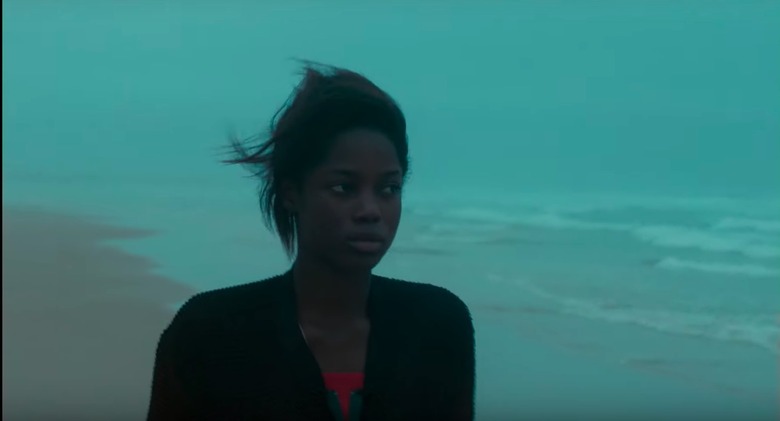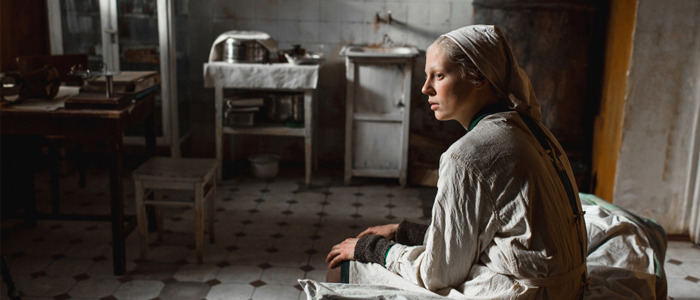5 Great Films From The New York Film Festival 2019
The New York Film Festival has always played host to a multitude of perspectives, from its globe-spanning Main Slate, to its experimental Projections programme, to the more recent, virtual reality-centric Convergence. The 57th iteration of city's premiere film event unfolded across two weeks at Lincoln Center, with this year's proceedings dedicated to the late Agnès Varda, an NYFF mainstay (her final film, Varda by Agnès, was also featured). The crown jewel of the fest was undoubtedly its Opening Night selection, Martin Scorsese's The Irishman. The ludicrously expensive Netflix production was so in-demand that even its press screening had to be moved from the usual location — the 268-seat Walter Reade Theatre — to Lincoln Center's prestigious, 1086-capacity Alice Tully Hall. Netflix also held the New York premiere for Noah Baumbach's Marriage Story (this year's Centerpiece film) and Warner Bros.' Joker even made its final festival stop after Venice and TIFF. However, lesser-known, unconventional works also found their way into the spotlight, like Catalan filmmaker Albert Serra's sexually-charged Liberté and Minh Quý Truong's experimental Vietnamese sci-fi doc The Treehouse.As usual, the programmers — among them, retiring festival director Kent Jones — scoured every corner of the globe for unique points of view, and the results were astounding. Here are five films from around the world that exemplify the best of NYFF 2019.
1. Atlantics (dir. Mati Diop)
Country: Belgium, France, SenegalLanguage: WolofAs the niece of legendary Senegalese filmmaker Djibril Diop Mambéty (Touki Bouki), Mati Diop has quite the legacy to shoulder, but she's also blazing her own path as the first Black woman to have a film play in competition at Cannes. Atlantique, or Atlantics, would eventually take home the Grand Prix, and it's also Senegal's entry for the 2020 Oscars.The film is an oblique ghost story about a doomed romance in Dakar — between Souleiman (Ibrahima Traoré), an exploited construction worker, and Ada (Mama Sané), a young girl set to be married off to a rich businessman. Souleiman and his coworkers set off to Spain by raft in search of a better life. When they disappear without a trace, their presence begins to be felt in mysterious ways, by the women they leave behind and by the corrupt boss who still owes them their living wage.Watching Atlantics feels like floating on water. It veers between ferocious anger and soulful calm, and the way Mati Diop and cinematographer Claire Mathon (Portrait of a Lady on Fire) shoot the ocean — with light shimmering off its uneasy surface — unlocks the entire film. It's furious, loving, and dreamlike, all at once.
2. Beanpole (dir: Kantemir Balagov)
Country: RussiaLanguage: RussianFrançois Truffaut is often misquoted as saying, "There's no such thing as an anti-war film." Contextually, he talks about how depictions of violence can be ambiguous, and says that "to show something is to ennoble it." If he were still around, he'd have been delighted by Kantemir Balagov's stunningly designed Beanpole, a film that manages to be anti-war through and through by refusing to depict war itself, focusing instead on the ripple effects of its devastation as it permeates society and molds people into their worst possible selves.Set in post-war Leningrad in 1945, the film tells of two women in love — towering-yet-demure nurse Ilya (Viktoria Miroshnichenko) and feisty returned soldier Masha (Vasilisa Perelygina) — and the havoc wreaked on them by the recent conflict. Beanpole is by no means your average queer text; mid-twentieth century society is a hurdle, certainly, but the lingering horrors of war prevent Ilya and Masha from being together more than anything else. Masha, whose wounds have left her unable to bear children, wants a child by any means necessary, even if it means forcing Ilya to have one for her. Ilya, who's taken to helping people after the devastation, suffers from a post-traumatic condition that causes her brain to lock down and her to body seize up, even in moments that might lead to her inadvertently hurting others. Both women are frozen by war, physically, emotionally, and financially. Even the film's most tender moments, as Ilya and Masha try to pick up the pieces of their lives, feel trapped within the confines of violent forces much larger than themselves — forces they may have no choice to succumb to, in body and in soul.
3. Pain and Glory (dir: Pedro Almodóvar)
Country: SpainLanguage: SpanishArguably Almodóvar's most tender work, Dolor y Gloria is part autobiography, part confession, and wholly reflective of the ways in which we remember (and like to be remembered). Antonio Banderas plays Salvador Mallo, an idiosyncratic arthouse director who feels like a stand-in for Almodóvar. He has Almodóvar's unkempt white hair and stubble, he dresses in floral shirts, and he even lives in an apartment that feels like a re-creation of Almodóvar's. After a long-standing disagreement with actor Alberto Crespo (Asier Etxeandia) over their film Sabor — from several decades ago — Mallo begins to re-evaluate not only his views on Crespo's performance, but on how he's lived his life, and all the people who have come and gone from it.The film follows a semi-retired Mallo in his fifties as he begins self-medicating his physical and emotional pain, but it occasionally flashes back to rosy memories of Mallo's childhood, involving his mother (Penélope Cruz), his early trysts with writing, and even his sexual awakening upon first seeing the male form in all its glory. As Mallo thinks back and reaches into his past, it fills within him a new desire to write, and in the process, to unearth the deepest, most vulnerable parts of himself — parts he had hidden away. Fittingly, Mallo's artistic resurgence draws a former lover (Leonardo Sbaraglia) out of the woodwork; warmth practically envelopes the screen as the two reminisce, and reflect on what could have been. The actor Crespo is representative, perhaps, of Carmen Mura, with whom the director had a falling out, though people are bound to mythologize the film as being about the long gap between his collaborations with Banderas; wouldn't that be poetic? How Pain and Glory will be remembered is out of Almodóvar's hands — something the director seems to articulate with Mallo's feelings on Sabor. While Mallo once hated the anguish Crespo brought to the film, he now sees his performance through different, more experienced eyes. With Pain and Glory, Almodóvar captures the intimate feeling of having your wounds and memories repaired by time.
4. Parasite (dir: Bong Joon-ho)
Country: South KoreaLanguage: KoreanMonster movie, murder movie, train movie, pig movie — whatever Bong Joon-ho makes, he imbues with an undercurrent of class angst, while his focus remains on the movement of people. He studies individual mannerisms, and the disorderly chaos of groups in motion; there's really no one better at it. With Parasite, he combines these two cinematic passions, making blatantly physical the ideas of class disparity while getting right in between the uncomfortable, subtle ways — nods, glances, turned up noses — in which social hierarchy manifests, placing invisible walls between people. A word of advice: skip to the next entry if you haven't seen the film. Parasite is a hard one to spoil, but it's also best experienced without foreknowledge. Its delights stem from its on-the-nose audacity, as a dirt-poor, basement-dwelling family of four, the Kims — college student Ki-woo (Choi Woo-shik), his unemployed artist sister Ki-jung (Park So-dam), his former athlete mother Chung-sook (Jang Hye-jin), and his former chauffeur father Ki-taek (Song Kang-ho) — slowly infiltrate a wealthy household by conning their way into jobs. The Park family, who own the lavish mansion, have westernized names (the Kims follow suit when choosing their pseudonyms) and remain blissfully unaware, for the most part, that they're being had. The Kims' methods range from underhanded (convincing the rich mother that her son needs "art therapy") to downright cruel (framing the current driver as a pervert, and getting the current housemaid fired by triggering her peach allergy), but the slick, sly precision of each plan makes it feel like an elaborate heist. That is, until the emotional core of the film comes into focus — a twist too good to spoil here — resulting in the Kims needing to double-down on their deceitful efforts.In order to keep their jobs, the Kims end up having to be crueler than anticipated to those as vulnerable as themselves — a byproduct of any capitalist rat-race. Bong captures spaces, both rich and poor, and the way characters interact with them, with precision — the same precision with which he films intimate, thoughtful moments. The Parks, 1%-ers though they may be, aren't knowing villains in any genre sense of the word. Rather, their obliviousness to the plight of those around them is both the mechanism by which the Kims take advantage of them, and the very force keeping them atop the social hierarchy (and the Kims near the bottom). As much as the Kims might impersonate, infiltrate, and occasional revel, the Parks' minor, thoughtless slights hurt much more than any physical violence in the film. Song Kang-ho, for instance, brings a specific kind of pain to Kim Ki-taek, a man who, despite essentially being a criminal mastermind, has his dignity slowly chipped away by the callous rigidities of rich behaviour. Parasite is a study of socio-economics, sure, but more than anything, it's a deliciously twisted thriller-comedy akin to a home invasion flick, filled to the brim with meaning and dripping with directorial mastery.
5. Portrait of a Lady on Fire (dir: Céline Sciamma)
Country: FranceLanguage: FrenchCéline Sciamma's follow up to Girlhood (Bande de filles) from 2014 — it's a crime she doesn't get to direct more often, by the way, though she did co-write My Life as a Courgette — Portrait of a Lady on Fire (Portrait de la jeune fille en feu) is a tremendously moving experience, and one that bides its time by design. Noémie Merlant plays Marianne, a portrait painter who feels plucked out of the present; her hair, her mannerisms and so forth make her feel like an outsider to the film's eighteenth century setting. Marriane is hired to secretly paint a pre-wedding portrait of Héloïse (Adèle Haenel), who doesn't want to be married and, like her sister, may even kill herself if she's forced to.Marianne accompanies the reclusive Héloïse on long, contemplative walks in attempts to observe her more closely. Romance eventually blossoms between them once Marianne's secret is out, but the path the film takes is intentionally askew. Portrait of a Lady on Fire is, at least at first, about the unknowability of a person. Marianne, who inherited her talents from her well-renowned father, paints within the constraints of a visual art form developed by men (and developed, in some ways, to contain and control women). So, her initial portrait only captures Héloïse's somberness, that too at a distance. As the two get more involved, Marianne is plagued by visions of Héloïse departing to get married; her brush strokes grow more passionate, and her painting more detailed. Adèle Haenel is only 30, but the film makes her seem gracefully aged; the lines around her eyes become sentences with which she tells her story — a story Marianne begins to reflect in her painting, as if in search of who Héloïse truly is. A lean-forward experience that demands patience and investment, Portrait of a Lady on Fire plays, at first, like a song with missed notes — until eventually, it discovers and carefully re-assembles them, revealing, in its final scene, the music of the soul.





